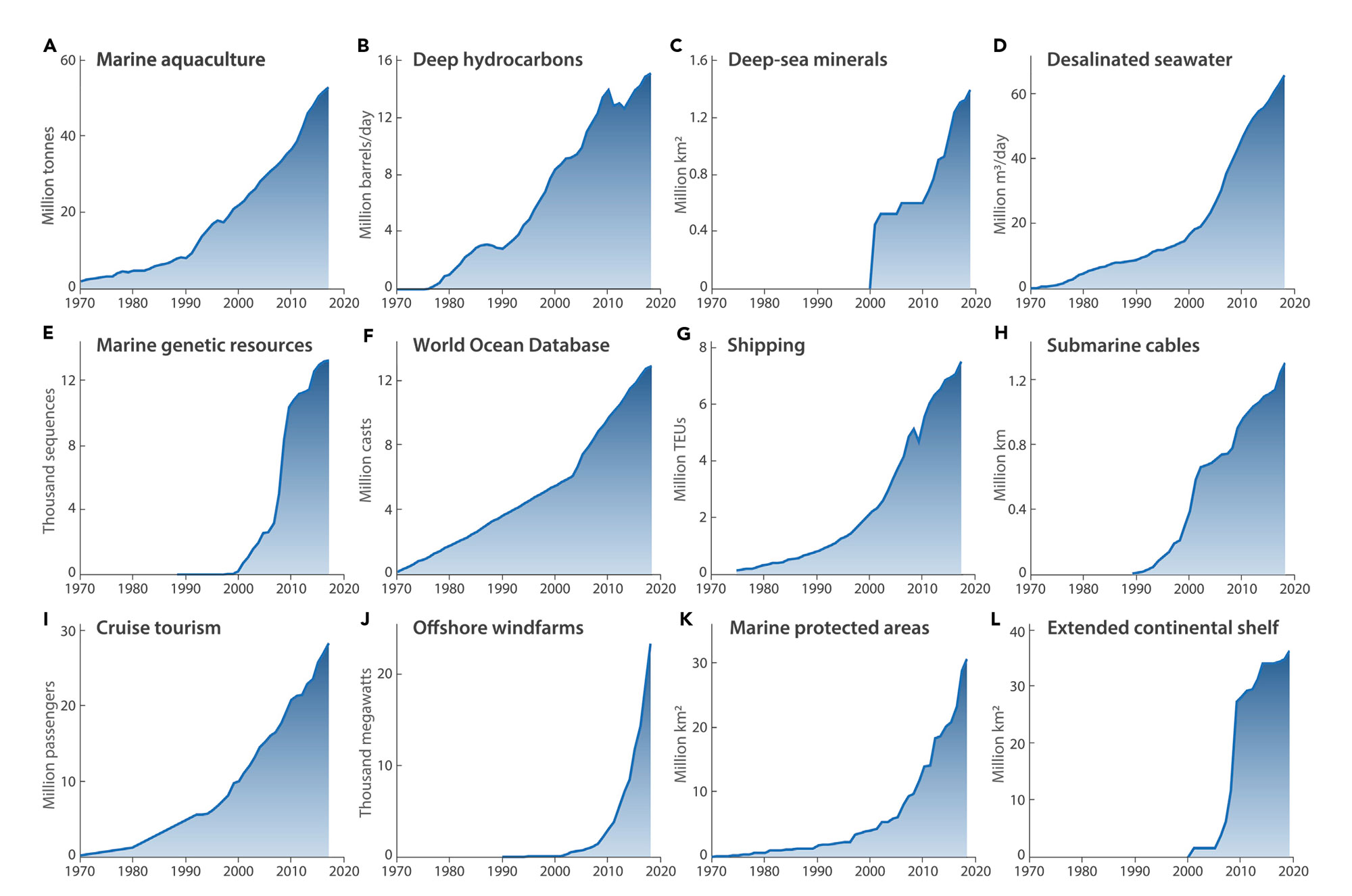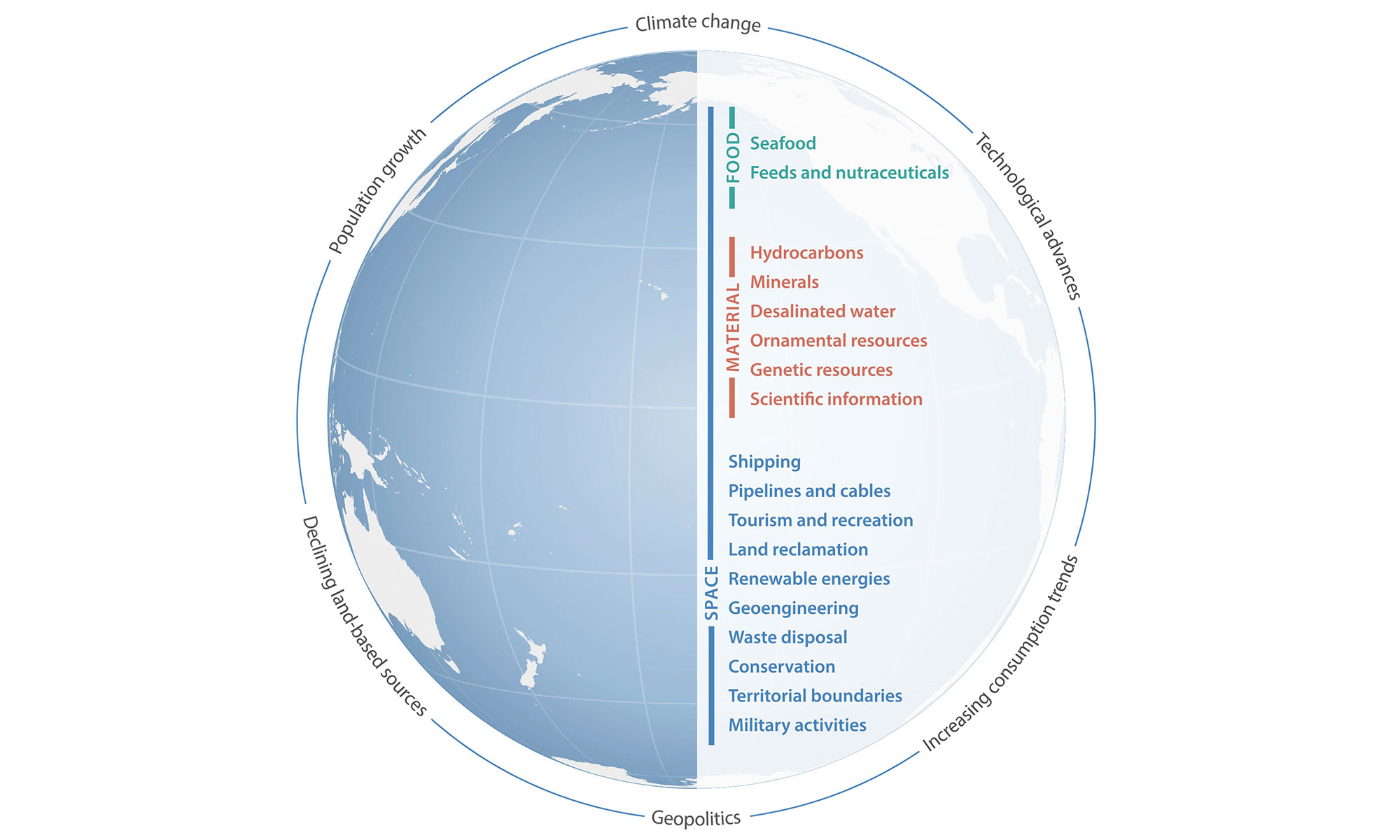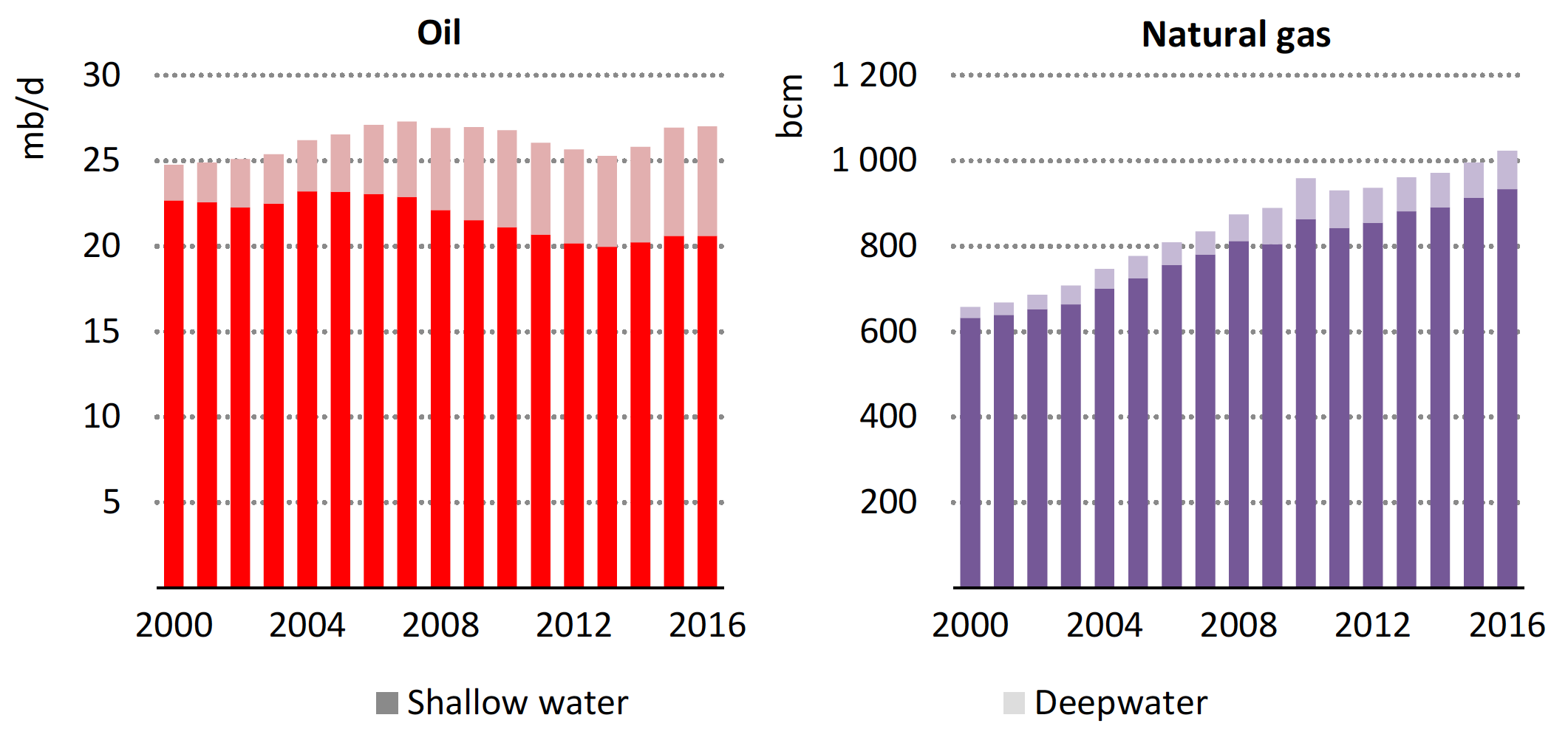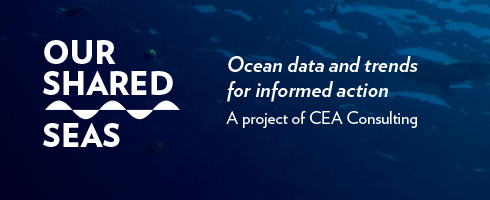Data Highlights
Size of ocean economy
2.5% of global GDP
Duarte at al, 2020
Employment by ocean sectors
1.5% of global workforce
Duarte et al, 2020
Volume of seaborne trade
10.7 billion tons (2017)
UNCTAD, 2018
Jump to:
Expanding claims on ocean resources
No area of the ocean is completely untouched by human impact. Apart from fishing, there are several industries (both long-standing and emerging) that are active on the ocean. Shipping and offshore oil and gas represent the two largest sectors economically and have the most significant ecological footprint on the marine environment outside of fishing. Among sectors with a smaller but still notable footprint, marine aquaculture has grown rapidly over the last two decades. Several other industries—including marine renewables, deep-sea mining, and biotechnology—are on the horizon. In recent decades, there has been a sharp uptick in human activities on the ocean and extraction of its resources, with a clear acceleration at the onset of the 21st century.1
Global Trends in Ocean-Based Industries

Note: Global trends in (A) marine aquaculture production; (B) deep offshore hydrocarbon production, including gas, crude oil and natural gas liquids below 125 m; (C) total area of seabed under mining contract in areas beyond national jurisdiction; (D) cumulative contracted seawater desalination capacity; (E) accumulated number of marine genetic sequences associated with a patent with international protection; (F) accumulated number of casts added to the World Ocean Database; (G) container port traffic measured in 20-foot equivalent units (TEUs); (H) total length of submarine fiber-optic cables; (I) number of cruise passengers; (J) cumulative offshore wind energy capacity installed; (K) total marine area protected; and (L) total area of claimed extended continental shelf. Source: Jouffray, J.-B., R. Blasiak, A.V. Norström, H. Österblom and M. Nyström. 2020. “The Blue Acceleration: The Trajectory of Human Expansion Into the Ocean.” One Earth 2 (1): 43–54.
The level of industrial activity on the ocean is expected to increase in coming years. According to the OECD, ocean industries generated USD 1.5 trillion in economic activity in 2010; this amount is expected to double to USD 3 trillion in 2030.2 Some sources refer to the trendline of human expansion into the ocean as the “blue acceleration.” As diverse and sometimes competing user groups seek to access food, material, and space in the ocean, there are calls to carefully consider concerns around equity and sustainability.3 While international policy documents and programs have advanced rhetoric of a “blue economy” in recent years, there is a lack of clarity on what the blue economy entails (e.g., whether there is a prerequisite for sustainability) and who benefits from such activity.4
Claims on Ocean Resources for Food, Material, and Space

The authors of the source paper identified and categorized these claims through an iterative process that sought to understand ocean uses of direct relevance for ecosystem sustainability, human well-being, and economic growth. Source: Jouffray, J.-B., R. Blasiak, A.V. Norström, H. Österblom and M. Nyström. 2020. “The Blue Acceleration: The Trajectory of Human Expansion Into the Ocean.” One Earth 2 (1): 43–54.
Footprint of individual industries
Offshore oil and gas accounts for production of more than 27 million barrels a day, representing roughly a quarter of global oil and gas extraction. This production is focused in five geographic hotspots: Saudi Arabia, Brazil, Mexico, Norway, and the United States. The future economic viability of the oil and gas sector writ large is uncertain as continued low oil prices converge with increasing cost competitiveness of renewable energy.5
Current trends suggest that offshore oil and gas production is slated to increasingly venture into deepwater and ultra-deepwater sectors, as many fields in shallow waters are nearly exhausted.6 As compared to newly discovered onshore fields, recently discovered offshore fields are about 10 times larger, which has provided an economic incentive for industry, in spite of high upfront costs and inherent environmental risk. Four countries–Brazil, the United States, Angola, and Norway–account for the majority of global deepwater and ultra-deepwater oil production.7 Since 2005, each of these four countries has increased its share of offshore oil production from deepwater or ultra-deepwater sources; this proportion is highest in Brazil and the United States, which represent about 90 percent of global ultra-deepwater production.8
Global Offshore Oil and Natural Gas Production by Water Depth

Source: International Energy Agency. “Offshore Energy Outlook” IEA: Paris, France. 2018.
As the offshore sector increasingly expands into deep and ultra-deep waters of the ocean, studies tracking the implications of the Deepwater Horizon oil spill of 2010 provide insight on the potential risks to ecological and human communities. The Deepwater Horizon spill led to an uncontrolled release of 5 million barrels of oil in the Gulf of Mexico, resulting in immediate death of marine life and substantial financial losses for tourism and fishing industries. However, a recent study found that biodiversity of microbes was flattened at sites closest to the spill, suggesting that the oil may have long-lasting impacts on the ecosystem for years after the initial spill, given that microbes make up the base of the food chain.9
The volume of global maritime traffic continues to grow, with direct and indirect ramifications for the marine environment. The global maritime industry has steadily increased in both the number of ships and in total shipping capacity. Roughly 80 percent of maritime traffic occurs in the Northern Hemisphere, with nine of the ten busiest ports all in Asia. Although considered less carbon-intensive than other land- or air-based transport options, shipping is responsible for approximately 3.1 percent of global greenhouse emissions (as well as “black carbon”), which are expected to increase 50-250 percent from 2012 levels by 2050.10 Shipping also contributes to pollution, invasive species, habitat destruction, and marine mammal mortality through dumped and spilled oil and waste, ballast water discharges, ship strikes, noise pollution, and dredging for shipping channels.
Growth of international seaborne trade
While most forms of aquaculture production involve relatively benign practices, environmental impacts do occur in the form of invasive species, disease, unnatural competition with wild fish, conversion of coastal habitat (mangroves), impacts on the seafloor, additional pressures on wild fisheries (for fish meal and fish oil) and chemical and antibiotic use. These impacts vary by species, geography, production system, and intensity. As the aquaculture industry is projected to expand to meet growing global food demands, advocates have called for the incorporation of sustainability concerns into the industry’s growth agenda.
Among emerging industries, the ocean is threatened from a variety of extractive or polluting industries such as deep-sea mining, desalinization, marine renewables, sand mining, submarine cables, and dredging and dumping. Both governance institutions and the conservation community are racing to understand the extent and impact of these emerging industries, which are venturing into increasingly remote areas of the ocean.
These changes are occurring against the backdrop of an already dynamic and evolving context in the marine environment, as climate change is altering species migrations, opening up new areas for potential shipping routes and mineral extraction, forcing considerations around ocean-based climate measures, such as the placement of offshore wind turbines. Given that economic benefits from the “blue acceleration” have historically flowed to dominant states and corporations—and harm has disproportionately impacted developing nations and local communities—there are calls to more explicitly center equity concerns to support a just and sustainable ocean economy.11
Notes
- Jouffray, J.-B., R. Blasiak, A.V. Norström, H. Österblom and M. Nyström. 2020. “The Blue Acceleration: The Trajectory of Human Expansion Into the Ocean.” One Earth 2 (1): 43–54.
- OECD. “The Ocean Economy in 2030.” OECD Publishing, Paris, 2016. http://dx.doi.org/10.1787/9789264251724-en.
- Jouffray, J.-B., R. Blasiak, A.V. Norström, H. Österblom and M. Nyström. 2020. “The Blue Acceleration: The Trajectory of Human Expansion Into the Ocean.” One Earth 2 (1): 43–54.
- Ibid.
- UC Berkeley Goldman School of Public Policy. “Plummeting Solar, Wind, and Battery Costs Can Accelerate our Clean Electricity Future.” June 2020. http://www.2035report.com/wp-content/uploads/2020/06/2035-Report.pdf?hsCtaTracking=8a85e9ea-4ed3-4ec0-b4c6-906934306ddb%7Cc68c2ac2-1db0-4d1c-82a1-65ef4daaf6c1.
- International Energy Agency. “Offshore Energy Outlook” IEA: Paris, France. 2018.
- EIA. “Offshore oil production in deepwater and ultra-deepwater is increasing.” EIA, October 28, 2016. Accessed March 18, 2019. https://www.eia.gov/todayinenergy/detail.php?id=28552.
- Ibid.
- Hamdan, L.J. et al. “The impact of the Deepwater Horizon blowout on historic shipwreck-associated sediment microbiomes in the northern Gulf of Mexico.” Scientific Reports 8 (2018). https://doi.org/10.1038/s41598-018-27350-z.
- Michelin, M., et al. 2020. “Opportunities for Ocean-Climate Action in the United States.” Report. San Francisco, CA: CEA Consulting.
- Jouffray, J.-B., R. Blasiak, A.V. Norström, H. Österblom and M. Nyström. 2020. “The Blue Acceleration: The Trajectory of Human Expansion Into the Ocean.” One Earth 2 (1): 43–54.

